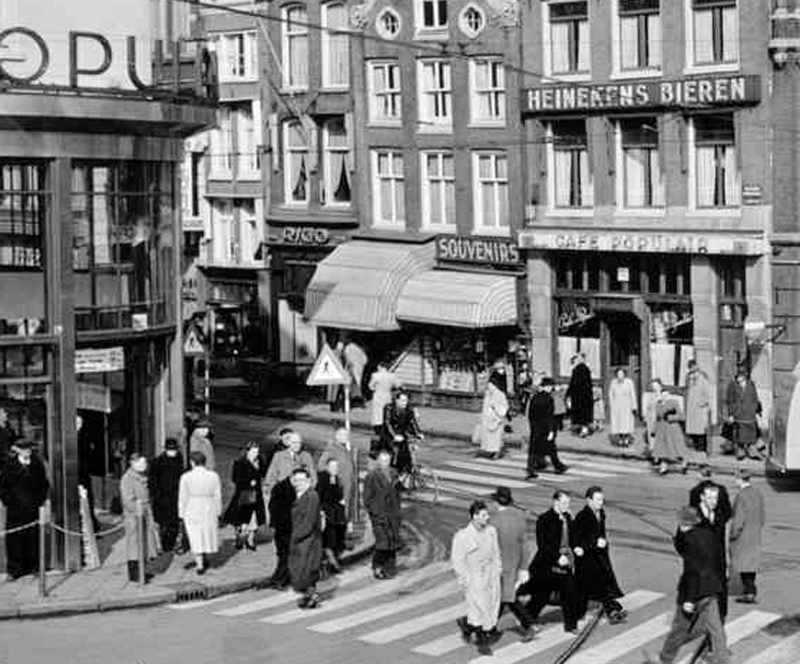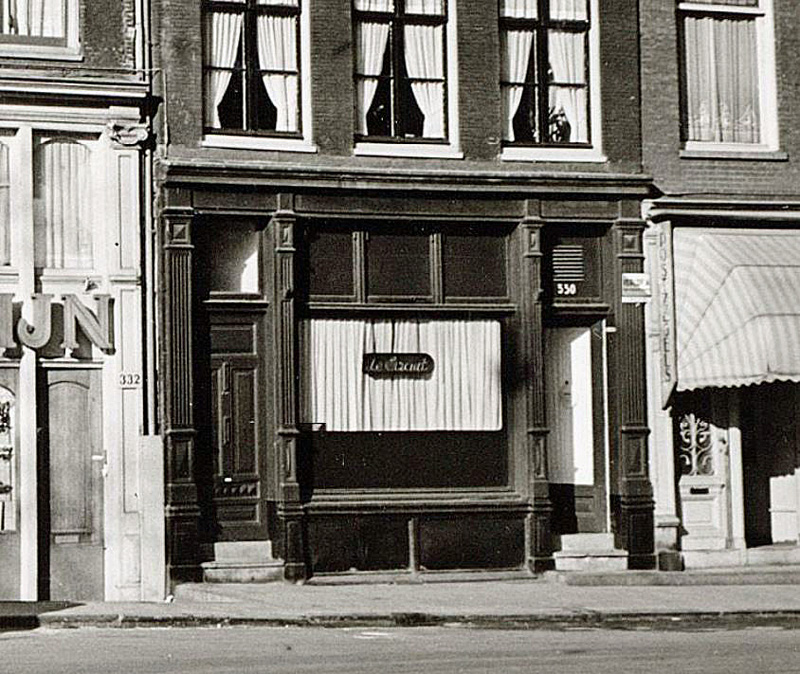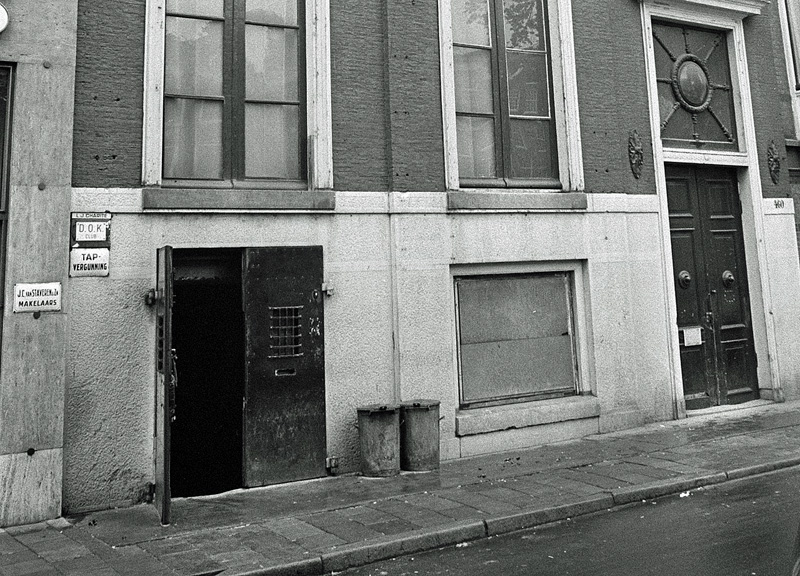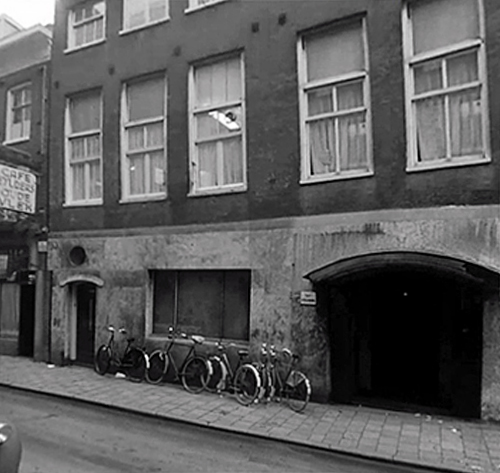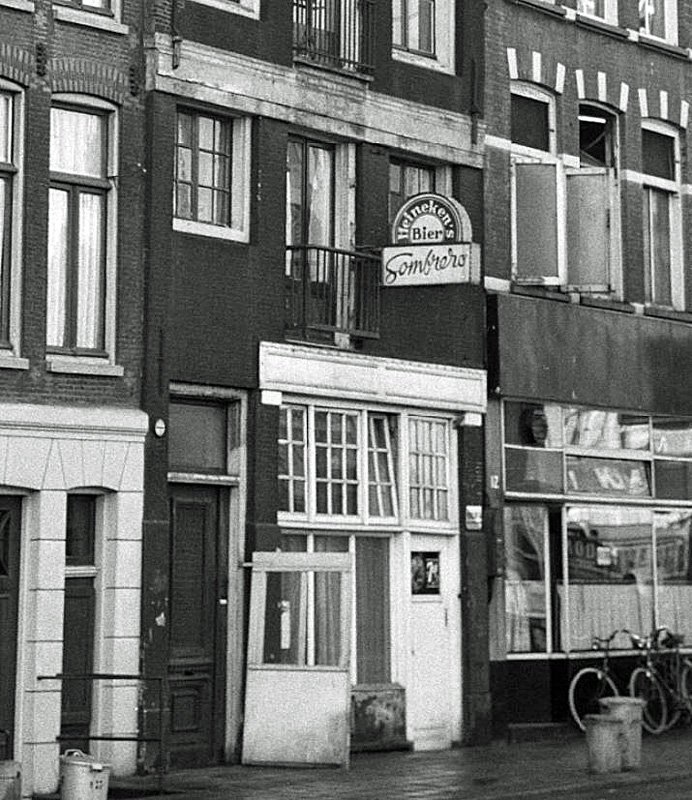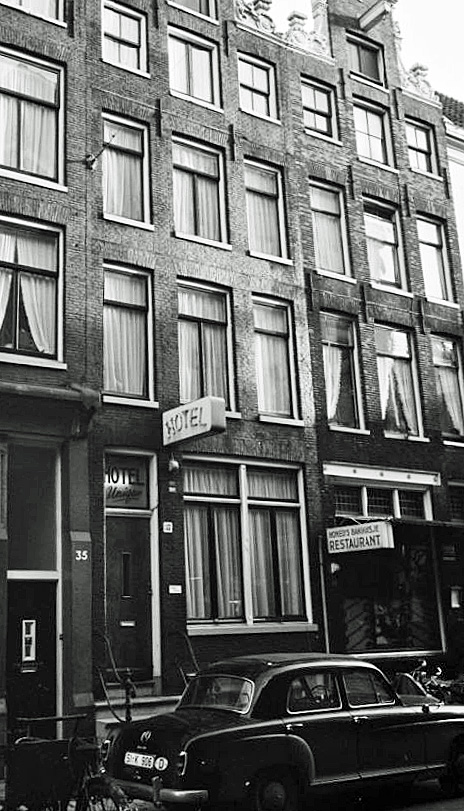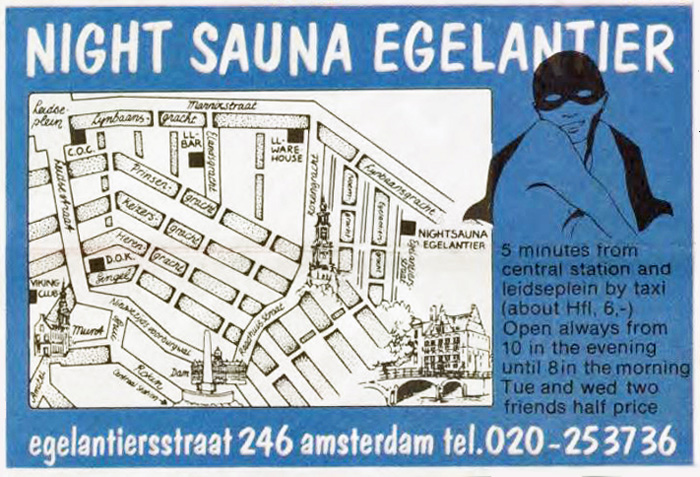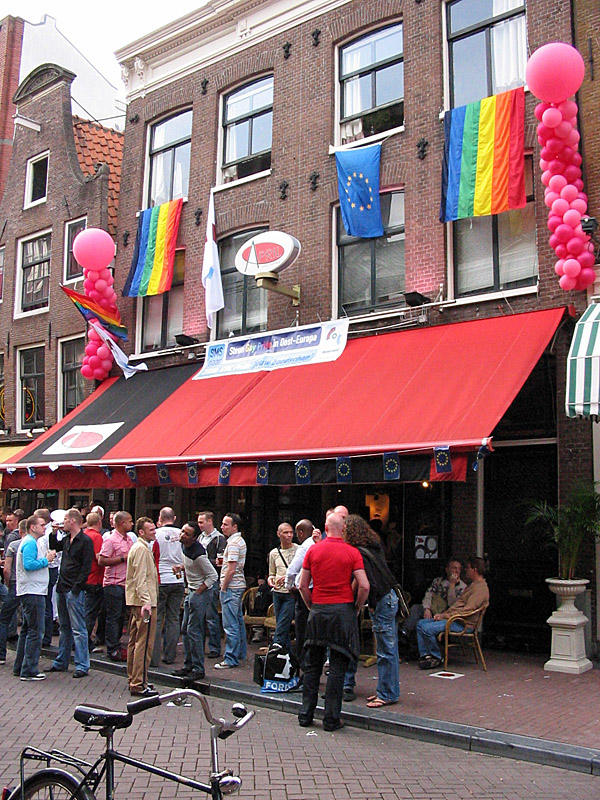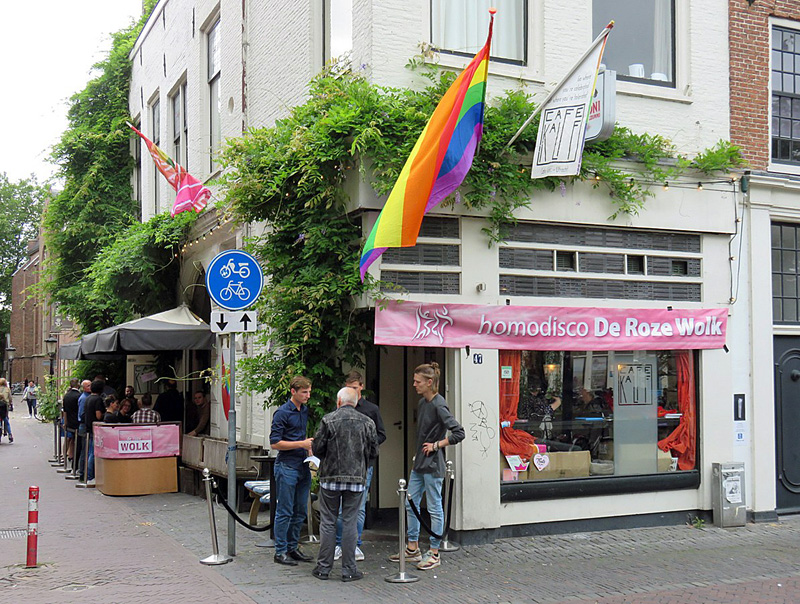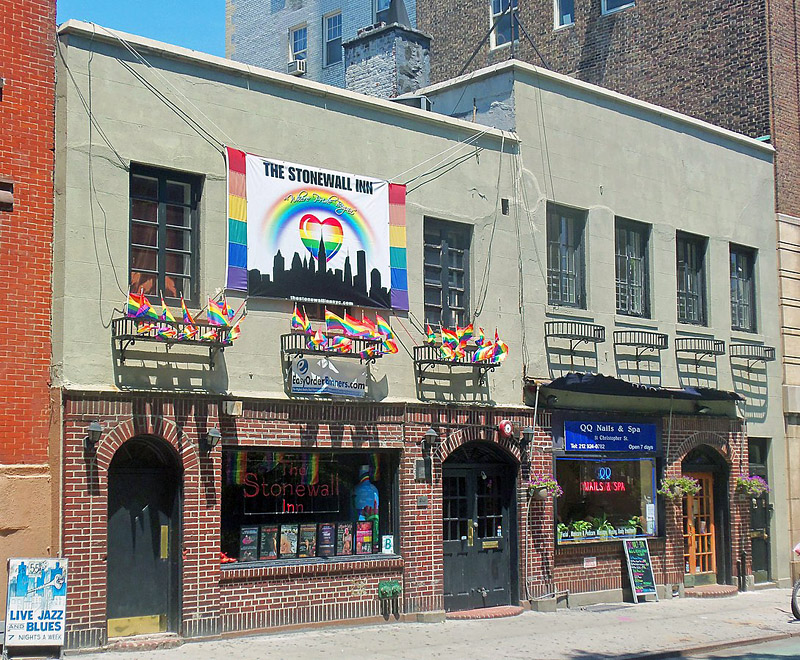R E S E A R C H
The Amsterdam Gay Bar Culture
1930-1970
1930-1970
By Gert Hekma (1951-2022)
Contribution to the congres 'Sexual Cultures in Europe' which was held in Amsterdam in June 1992
In research by myself and some of my students on the Amsterdam gay and lesbian bar culture, 1930-1970, we discovered that not only the geographical landscape of lesbian and gay culture changed dramatically in those years, but also the identities of gays and lesbians. In this article I explore these themes.
To indicate the changes in identities, I speak about dykes and queers for the period prior to 1955, and about (male and female) homosexuals for the period after. The Dutch terminology is "pot" en "nicht" for the first and "homo(sexueel)" for the second period. This distinction is distilled from our material, but although we feel that this distinction should be made, all words are used interchangeably in both periods.
As a general term, I use gay and lesbian (which I realize is also misleading). The research is based on interviews with 20 gay men and 8 lesbian women in the age range 50-83 years most of whom had been active bar-visitors, and on archival materials.
The Amsterdam gay bar culture
Our research interest was in the first place the deployment of the gay and lesbian bar culture. In Amsterdam there were only a few bars of this kind in the thirties, and there were very many from the sixties on. Almost all bars in both periods were predominantly gay and some were mixed gay/lesbian. An exclusively lesbian bar opened only at the very end of this epoch. Nevertheless, many bars prior to 1955 were managed by women, mostly dykes, who often came from the world of whores.
The bars can also be divided according to their localization. Nearly all gay and lesbian bars were in the center of the city. There are three main areas for entertainment in the center of Amsterdam in this century, the first the Zeedijk and the Red Light District in the North-eastern part of the center, the second the Leidseplein to the Western side and the third the Rembrandtplein to the South-eastern side. In all three districts were gay and lesbian bars.
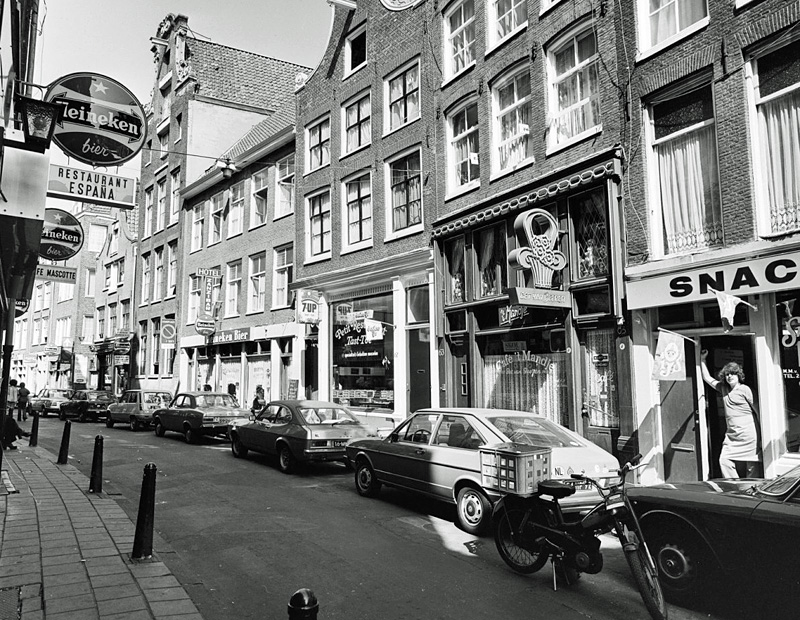
Zeedijk in 1976 with Café 't Mandje as the second place from the right
Photo: Han van Gool - click to enlarge
Photo: Han van Gool - click to enlarge
The Zeedijk region is considered to be very lower class, the center of sex and crime. It was the traditional district for sailors, whores, pimps, blacks, and so on. It was a Genet-like climate where Genet also liked to come in the fifties and sixties. The Rembrandtplein is lower and middle class Amsterdam popular culture where you will (and could) hear the local music. The Leidseplein was middle and high class culture, with the cinemas and the Stadsschouwburg and at its back the State and Municipal Museums, and also the Concertgebouw.
With the establishment of the Stopera in the 80s, both last cultures have become more mixed, part of high culture moving to the Rembrandtplein whereas the Leidseplein was inundated with middle class youth culture. Most of the gay and lesbian bar culture was not in the center of those districts, but at the margins of it, in small alleys around the big squares. Only at the Zeedijk you could find gay/lesbian bars.
Specific gay & lesbian places
In the thirties, gay bars were in between all centers, near the Kalverstraat which connects the three nucleus of diversion. The two most important were the Empire (1928-1935) and Huize Volendam (1933-1940). These were both predominantly gay bars where some lesbians came. The Empire was in the Nes 17, near the Dam Square, and Volendam in the Watersteeg 4, ten steps from the Kalverstraat and two blocks from the Spui.
The first bar was owned and managed by Mie Lauffer, probably a former prostitute and a lesbian who smoked cigars. Bob Scheper took over from her. He was a gay man, married to a woman who seems also to have been active in prostitution. In 1932 the police raided the bar, and shortly after Scheper moved to the Watersteeg. His former waiter Rijntalder took the Empire over from him, and left it again in 1935 for a new bar at the Amstel 124, that also got a gay and lesbian reputation.
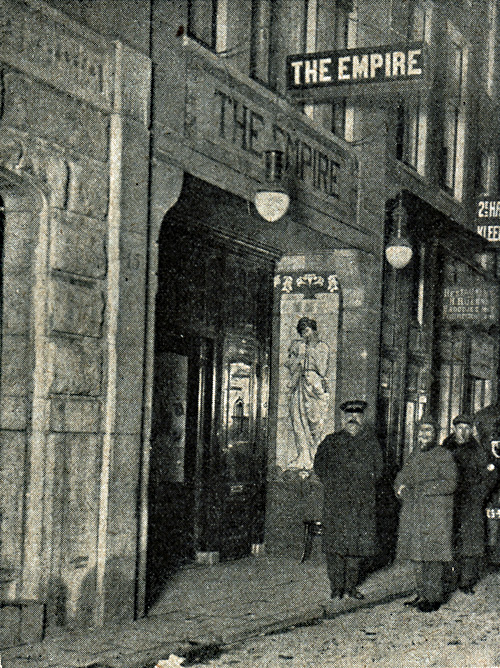
The former café-concert The Empire at Nes 17, where later
the gay bars Maxim and Bob's bar-bodega were located
the gay bars Maxim and Bob's bar-bodega were located
Unknown photographer - click to enlarge
Then there were three bars with a strong gay/lesbian clientele: Du Merlo at Amstel 14 (?- 1934), the Rheinland or "dime-bar" in the Warmoesstraat 77 (1932-1936) and Populair at Singel 536 (1934-1942). Several mixed straight-gay bars also existed, the most famous being 't Mandje owned by Bet van Beeren, a real dyke, perhaps the most famous lesbian of 20th-century Amsterdam.
't Mandje and Rheinland were in the Zeedijk-district, Du Merlo, Populair and Rijntalder's Amstel 124 near the Rembrandtplein. We have to stress that the most important meeting places for queers in those times were not bars but tearooms, of which there were probably more than 40 gay-active in Amsterdam, two of the most important being under the Munt-tower and on the Rembrandtplein. On both places were also the hustlers at least since about 1900. Du Merlo was around the corner from the Munt-tower, Populair had a good view on the entrance of the tearoom under the Munt-tower.
The names of these bars were rarely known by the gay men, they knew the names of the barkeepers, like Mie Lauffer, Arie, Bob Scheper, uncle Henk, fat Annie, Bet van Beeren. Both Henk and Arie (from Amstel 14) were straight men. Henk was the owner first of Rheinland and then of Populair. Annie who managed the Volendam, came also from the world of prostitution. All these bars, especially the exclusively gay ones, were heavily controlled by the police. Two inspectors, one responsible for sex and the other for alcoholics, made once a week a tour of 10-20 bars, and visited regularly the gay bars.
Their reports give a lot of information on the precise location of those bars and what happened in them. The officers controlled the bars on the presence of female bartenders, unauthorized drinks, music, opening times. For all those things bars needed permissions. Moreover, the police- officers looked in the queer bars for minors (under 21 years) because the age limit for gay and lesbian sex was 21, whereas straight sex was legal from 16 years on.
What bothered the officers most, were prostitution and homosexuality. Bars where they spotted "homosexueelen" or which they considered to be a "homozaak" (homobar) could forget about their permissions. (The officers spoke indeed of homo and homosexual, and also about "flikkers' which is close to queer.) But of course the problem was how to spot the queers, because the police had no methods to identify sexual preferences. So, they spoke in their reports always about "probably homosexual", "woman of a homosexual type", and so on.
The managers always explained that they wanted to get rid of this public, and with good reason the police did not believe them. Only once, Scheper asked why he should not allow homosexual clients in his bar. Which made him only more suspect in the eyes of the police-officers who traced all his activities in Amsterdam, and once arrested him for a very minor offence on a Leidseplein-terrace. It was also his bar that the police raided in 1932.
Because of police control and social prejudice the gay bars had to be very prudent. Therefor they developed alarm systems to warn for unwanted visitors. The Empire, Volendam and Rheinland had doormen who rang a bell when such visitors came along or worked with a mechanism which put on a little light when visitors arrived. Such lamps were sometimes in the eyes of an porcelain owl which seems to have been generally used in bars and boudoirs to burn scent to give the place a better smell. The secret meaning was that queers referred to straight as "uilen" (owls).
These precautions were necessary to give the bar a "normal" appearance if policemen or straights entered. Intimacies were not allowed, and for the police the barkeeper had also to hide alcoholic drinks and to put off the music for which most gay bars had no permission. So, drinking and dancing had to be concealed. How terrible this repression may have been, the gay men we interviewed also saw the charms of this secrecy. However, the police was well aware of these alarm systems.
What happened in these bars? Virtually nothing, because the police controlled them so strictly, and because the bar-owners and visitors complied with the strict rules set by the police. Only one of the men interviewed (of five having been active before the war) told that he once had sex in the toilet of the Empire, and the police noticed that the public in the Rheinland made very frequently use of its toilets, but in general the bars were very decent places.
The bars were not so much places for cruising and picking up sex partners, but protected places to be among like-minded people, among gays and lesbians. They were places where you could be yourself. They resembled in this respect circles of friends which gays and lesbians formed. Sex you would find somewhere else, the best places being the tearooms and the red light district.
Moreover, gays and lesbians were at that time "nichten" and "potten", queers and dykes, who had gender-inverted identities. Their main sexual interest was not so much in other dykes and queers, but in men and women whose gender-identity was not inverted. "Tule" is the queer word for beautiful straight (young) men, many of whom ventured into sexual contacts with queers, as straight women did with dykes (but for them there does not seem to have existed a special term).
"Tule" is an amazing word, because it refers to an exquisite linen used for ballet-clothes and bridal gowns. Does it refer to the beauty of the "tule" or to their status as sex partners for the queers? Or has it an etymological relation with a German word which means dick? We do not know as yet. This interest in men and women of an opposed gender identity can be explained by dominant ideas on sexual attraction as appeal between opposite poles.
We have also to realize that the structure of gay (and in another way lesbian) desire was completely different: with many people being involved in gay sex and few having a gay identity, finding a partner in this secret and forbidden world was for a gay man very difficult. Most gay loves will have been directed toward "tule" only because of sheer chance. Of course, not everybody lived according to such ideas of "nicht" and "tule", but they were important in shaping a social structure of desire.
It is a structure known from studies on sexual inversion and from gay and lesbian literature from this and an earlier period, such as M. Hirschfeld, J. Ackerley, M. Proust, R. Hall, J. Genet and so on. Gay men were interested in sailors, soldiers, working-class boys. And lesbians in "real" women, "femmes". For these reasons, a gay and lesbian bar culture had some difficulty to develop, not only because of police interventions, but also because sex was sought outside the world of queers and dykes.
Especially at the male side, another factor enhanced the possibilities to find sexual partners among straight men because these men had restricted possibilities to have sex with women. Men and women were different according to sexual ideology and practice, men actively pursuing sex and women shying away from it because they had to fear pregnancy and loss of reputation and of virginity. So men had difficulty in finding female partners.
Unmarried young men could neither pay prostitutes, so one of the easier ways to have sex was with queers. (Another possibility was to have sex in one's peer group.) As queers were defined as shameless, unmanly persons, there was no loss of reputation involved in this sex, it could even enhance the masculinity of supposedly straight men.
Additional factors could make it easier for them to have queer sex: being drunk, getting money and being a foreigner to the place (as sailors and soldiers generally are). Especially in the red light district queers could pick up straight men, and in this world of prostitution where "lewd" women assembled, also dykes could find sexual partners. Some of the bars at and around the Zeedijk were owned by dykes, and there lesbians certainly found a niche.
During the Second World War, the Netherlands were occupied by Nazi-Germany. The Germans introduced legislation which forbade all male homosexual contacts, but notwithstanding their efforts, in Amsterdam several new gay bars opened, some of which also visited by German soldiers. The most famous was Café Populair (later Monico) owned by the lesbian Saar Heshof and started in 1941. Till this day she is standing behind the counter of the bar in the Lange Niezel 15 near the Zeedijk.
Heshof's bar was raided at least once by the police during the war, and was denounced in the weekly of the Dutch SS. This was a bar for both dykes and queers. The other bars were mostly gay. The Marathon existed for a mere year in the Regulierdwarsstraat 93, being harassed out of existence by (Dutch) police control. The Rigo, started by an Italian in 1943 in the Regulierbreestraat 47, survived the war and existed till 1953. The last two bars belong to the Rembrandtplein-district. Near the Rigo on the Thorbeckeplein was already the bar of Hotel Thorbecke, which was a mixed gay/straight bar and continued as such till 1970.
After the war, the gay bar culture developed rather smoothly. 't Mandje, the Rigo and the Monico survived the war. Immediately after the war, the hustler bar the Jamaica Inn started in the Voetboogstraat 4. It became a major attraction of the gay world till it closed down in 1980. The Jamaica was in the middle of the center, near the Kalverstraat and the Munt-tower, but not really belonging to one of the three districts.
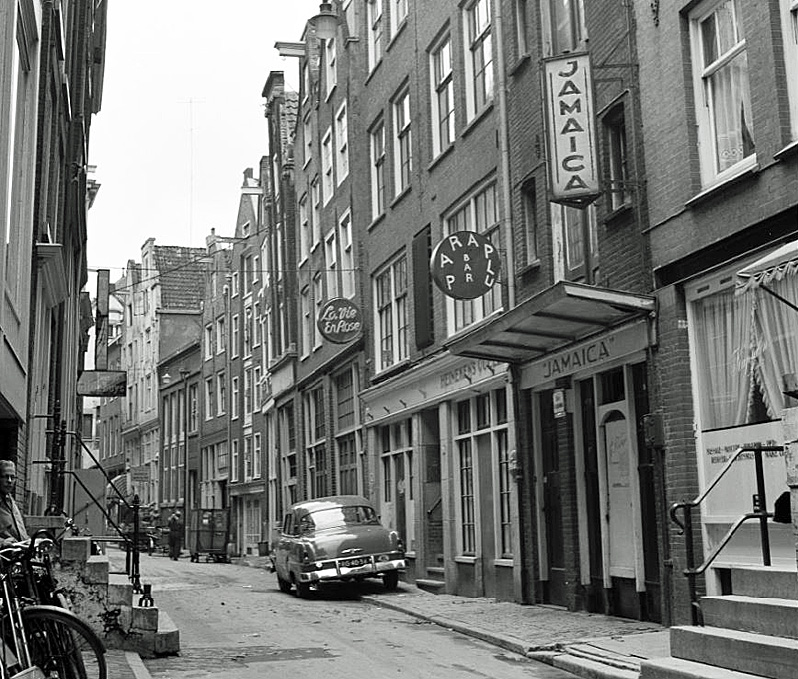
The Voetboogstraat in 1956 with three gay bars:
La Vie en Rose, Paraplu and Jamaica Inn
Photo: C.P. Schaap/Stadsarchief Amsterdam
La Vie en Rose, Paraplu and Jamaica Inn
Photo: C.P. Schaap/Stadsarchief Amsterdam
Around the corner, on the Spuistraat 330, the Circuit started around 1950, run by the spouse of Scheper. It was, like the Rigo, a bar for the elegant and rich queers where rarely hustlers were to be found, so it belonged to the Leidseplein-district, although it was rather far away from there. The public tended to be actors, fashion-designers, and so on, and arrived in the bar after Concertgebouw or Stadsschouwburg ended.
Near the Rigo was for a short time a mixed gay/lesbian bar 't Kooitje run by "Haagse Jopie" which was even in comparison with the small Dutch bars a very small bar of less than 20 square meters. Haagse Jopie was a lesbian and a former prostitute. The most important addition to gay and lesbian life after the war was the start in 1946 of the homophile movement, the Shakespeare Club, later renamed COC (Center for Culture and Diversion).
Diversion was forwarded one or two days a week in the club of the COC, which moved through the city for 6 years before they had their own "national home" in "De Odeon Kelder" (DOK, the Odeon Basement, the Odeon being a former theater) on Singel 460. This was in the vicinity of Jamaica and Circuit. In 1955, Lou Charité took over the DOK from the COC in a way that called upon him the eternal wrath of the COC. He made it into the most swinging gay dancing of the world before Stonewall.
The same year, the COC started its own dancing five steps from the Leidseplein, De Schakel. In both dancings, lesbian women were a tiny minority. These dancings represented a radical change in the gay landscape. In the first place because their existence was allowed, and what was perhaps as remarkable, they were two of the very few dancings (perhaps from a total of four) to have permission to be open till two and in the weekends till four in the morning.
The policy of the police and the city seems to have been that the gays should dance and not cruise streets and tearooms. It was a preventive policy which opened the door for many gay endeavors. In the second place, these dancings represented a shift in gay and lesbian identities. Especially the DOK became a meat-rack, a place to pick up sexual partners.
Gays were no longer queers, posing their effeminate manners and lurking after normal men, but homosexuals who were no less masculine than straights. They now desired sex with other homosexuals, and not the insecure border traffic with "tule". This word "tule" even underwent a change in meaning, now indicating straight male hustlers. In the circle of homosexual women, the dyke who drank jenever (a Dutch strong liquor) and smoked cigars, became also slowly an outdated figure. Later, I will go into other aspects of this sexual evolution.
Around 1955, many gay/lesbian bars opened, or straight bars got slowly a gay/lesbian public. In the vicinity of the Rembrandtplein, the Regina and the Krokodil, mainly hustler bars; the Nightclub of the Polish-Jewish lesbian "Moor", Selma Lewkowitz, also an offshoot from the prostitutes' world, which was an important mixed gay/lesbian bar; the Festival, a bar for a better kind of gay public, and the Copacabana for mainly a lesbian public, which never became very fashionable, both in the Paardenstraat; and the Sombrero on Amstel 14 (where the Du Merlo had been before the war) became again a gay bar.
On the Zeedijk, the Violetta run by the lesbian Hein Gerber, was a haunt for lesbians and gays. Next to the Jamaica, the Paraplue became gay. New attractions were two hotels. In the Kerkstraat 37 opened Hotel Unique in 1951, which was a specialized hotel for gay tourists. Many such hotels followed, as West-End at the other side of the street with the bar Cosmo. Amsterdam got a reputation as a gay paradise and such hotels catered for the tourists coming to the city.
Hotel Tiemersma did not become famous for its hotel, but for its bar, the first leather bar in Europe according to one of the interviewed men. It opened about 1955, was very simple, the bar being the living room of the owners. In the basement was a storage room and toilet with a passage leading to them and there the first dark room of Amsterdam started. The rooms of the hotel could not be locked very well, so it was really a hotel for easy, heavy and masculine gay sex. This leather culture should have imported from England, Amsterdam being the first city on the continent to have such a bar.
Shortly after this upsurge of gay bar culture, the Fiacre opened in 1959 in the Lange Leidsedwarsstraat 19, two steps from Leidsestraat and Leidseplein. According to the interviewed gay men, it was the epitome of everything the sixties stood for: freedom, social integration of hetero- and homosexuals, acceptance of homosexuals. It was a well designed bar, whereas all older bars were simple and without much decoration.
The Fiacre was certainly a very open place where the (gay) artistic crowd of Amsterdam gathered, the fashion designers, the actors, the boys from the ballet, literary people. It was a major meeting place for cultural circles, but not a meat-rack as the DOK. It was a place to make friends and to drink, not to find casual sex. For sex, the visitors should move on after closing time to De Schakel which was around the corner, or the DOK, at the other end of the Leidsestraat.
In the sixties, a flood of gay bars overrun Amsterdam, too many to name them all. The most important new elements were some expensively decorated bars in the Kerkstraat as the Incognito and the Bonaparte, with the first (mixed) coffeeshop Do Brazil around the corner in the Leidsestraat, the MacDonald in the Regulierdwarsstraat, the starter in this street which is nowadays heavily gay, some new and popular bars near the Rembrandtplein as the Cheval Neuf next to the Festival in the Paardenstraat and the Amstel Taveerne.
The Sombrero was taken over by Moor who made it into a very renowned bar, Eldorado, for both lesbians and gays. There, lesbians seem to have had sex in the toilets, a very remarkable feat in Amsterdam bar culture. Hotel Tiemersma for the leather men was so successful that it opened a bar around the corner, the Argos, in the Heintjehoeksteeg.
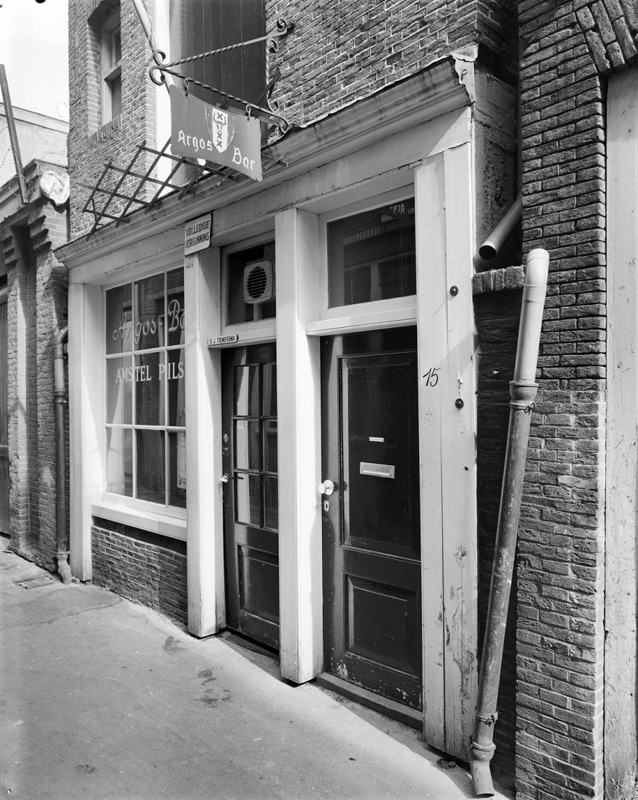
Argos Bar at Heintje Hoeksteeg 15, here in 1975
Photo: Gerard Dukker/Rijksdienst voor het Cultureel Erfgoed
Photo: Gerard Dukker/Rijksdienst voor het Cultureel Erfgoed
The last and also very important institution to appear on the Amsterdam gay stage was the sauna or bath. The first were the Egelantier, the Moderne and the Athletic, which all started around 1965. Before that, you could only find them in The Hague. With these additions Amsterdam had a very diverse gay bar culture which became a major attraction point in Europe. Germans and English flocked to Amsterdam to find the pleasures they could not find at home.
This growth of gay bar culture posed moral problems to City Hall, where they considered to bring down the number of gay bars. But the times had evolved so far that a major attack on the gay institutions which had been permitted so long by the police, did not come along anymore. Sexual reform had made a major breakthrough in the Netherlands and the gay bar culture profited from it.
Although most parties in City Hall were in favor of measures, and although such measures should not have been met with strong opposition by the public seen the prevalence of negative attitudes among the general population against gay bars and the fear in which most homosexual men and women still lived, nothing firm was done.
The changes after the war
The change in the gay and lesbian bar culture is very clear. By the sixties there were many more bars than in the thirties. Moreover, the bars had become more stable. The life-cycle of an exclusively gay bar was in the thirties rather short, at most 8 years, whereas the Monico now exists for more than 50 and the Jamaica and the DOK existed for nearly 35 years. Many still existing bars and hotels started in the fifties: Unique, Cosmo, Krokodil, Festival.
A second important point is the disappearance of the doormen and the alarm systems used against unwelcome intruders in the gay and lesbian world. Formerly the bars had curtains and closed fronts to prevent the possibility to see from the outside what happened inside. Many bars now have open windows on the street and last year even the first leather bar got this. The gay bars have gone through repression and acceptance and now they are considered an important asset to Amsterdam city life.
Thirdly, the homosexual and mixed bars now are less frequently run by women, lesbians and/or whores. Nearly half of the bars from the thirties till the fifties were owned by women, and they offered a shelterplace for dykes. This kind of bar slowly disappeared from the Amsterdam scene as women lost their place in the world of prostitution to pimps and other males. The famous Bet van Beeren died in 1967 and this could be considered the beginning of the end of the dykes' bars. Only in 1970, an exclusively lesbian bar [Tabu at Leidsekruisstraat] was opened.
In the fourth place, the queer bars were very decent places where you did not have sex. At the other had, half of them worked with male hustlers, so one could provide for one's sexual desires, and go home with a rent boy. Only with the start of the Argos at the end of the fifties, sex was taking place in the bar itself. The baths were a major addition for this system of sexual promiscuity inside gay institutions, whereas it formerly happened in the streets.
The last point is connected with the following discussion on gay and lesbian identity. The bars were in the thirties mainly places to meet people of the same kind, so other queers and dykes, or rent boys. But in the sixties, the male homosexual bar culture was a place to meet sexual partners which had earlier been picked up on the streets, in tearooms and parks.
Changing gay/lesbian identities
The queers had become homosexual men who laid off their "nichterigheid" (queerness). Being queer was something of the past, it was something connected with dirty talk and open discussion of sex. Homosexual men hid their sexual interests and exploits for each other, queers claimed among each other the qualities of their booty. It meant also that the effeminacy which had characterized the queers, became unfashionable among homosexual men. But the most important point was the change in sexual desires.
Earlier, queers tried to seduce "tule", normal men, and they succeeded to pick them up because they took the feminine role in courting and sex. Two of the men we interviewed had an extra-ordinary story of an old queer who lived next to Saar Heshof's bar in the Lange Niezel, which is the main entry to the red light district. This older powdered queen tried in the fifties to attract from his door the passing boys, and he must have succeeded. They could not tell if this man was paid for the sex, but this example illustrates the typical distribution of gender roles among "nicht" and "tule".
After 1955, homosexual men did not languish any longer for normal men, and the straights did neither need the queers for sex. They earned more money so it was easier for them to visit prostitutes, and moreover, sexual norms had become less strict so straight sex was easier to come by. Another remarkable story which illustrates the change in sexual desires is from the man who told about the beginning of the leather culture. This man was clearly interested in masculine poses and comradely loves.
At the same time he told of a friend of his who was lurking after "tule" on the Zeedijk. When I asked him if they did cruise together, he firmly denied so, because the macho men he looked for were completely different form the "tule" his friend wanted. The difference, he made clear, was in their sexual identity. The leather scene was a homosexual world, and the world of "tule" was a straight world.
This brings us to a pivotal point. The relations and contacts of the queers were mainly casual, modelled after the sexual behaviors in the world of prostitution. It was based on a social and a gender difference; the queers being middle or high class and effeminate, the "tule" being working class and masculine.
Financial rewards were often part of the game (not only direct payments, but also jobs, food, drinks, presents, loans, and other favors). There was little future to such relations because they were basically sexual and not social. "Tule" was always lost to marriage.
With the advent of the male homosexuals, they found their objects of desire among themselves, and the gender roles became interchangeable. Social class had little importance anymore in establishing relations. The new ideal of homosexuality became a stable relation or friendship.
The mythology of the "vaste vriend" (steady friend or lover) then started. Notwithstanding the meat racks of DOK, the baths and the Argos, the ideal became such a stable love relation. The continuing promiscuity was part and parcel of queer tradition and the male socialization of gay men.
Homosexuality now moved upward, from being a copy of whoredom it became a copy of marriage. Only through this change in ideals and ideology, the social integration of homosexuals became a possibility. At the same moment the sexual border traffic between straight and gay men diminished strongly. The advent of the gay bar culture was a major change in the homosexual world.
It was a change-over from a mixed gay-straight world where sex was for many men incidental (only for the queers regular) to an autonomous homosexual world where much less, mostly homosexual identified men, had much more sex: an acceleration of homosexual activity with a diminution of the number of men involved.
Comparatively, the question arises why changes in sexual identities proceeded in all societies of North-western Europe along more or less the same paths, whereas changes in sexual tolerance were rather unequally divided among the same nations. These differences in level of acceptance will probably lead to new differences in sexual identities, in social integration and in self-articulation.
So, gay and lesbian styles in the UK and the Netherlands show already remarkable differences which they always did, which we implied should diminish, but are getting stronger again because of another sex-political situation. But to understand how these developments relate to or differ from each other, we need to know more about the situation in other countries.
Anyhow, the change from queer to homosexual was a major breakthrough with many consequences. One of the results in the Western world was a stronger and more self-conscious gay and lesbian culture which has become the basis for a gay and lesbian movement whose social and political influence can no longer be denied. Whereas the queers were shameless effeminate gays who liked sex and not politics, homosexuals wanted love relations and started gay politics.
Notwithstanding ideals of integration, as formulated among others by the COC, the Dutch "homophile" movement, the gay & lesbian culture and movement got more autonomous and more diverse without becoming getthoized. This speeded up gay & lesbian emancipation, certainly in the Dutch situation.
To some queers and dykes, it meant liberation. Many older gays and lesbians remained in the closet, and some of them still complain about the disappearance of the multiple sexual chances the old system offered.
Gert Hekma, Gay Studies, University of Amsterdam
This text is copied from FMG.UvA.nl and can also be downloaded at Academia.edu. Subheadings and photos were added for publication on this website.
The article is a summary of Gert Hekma's book De roze rand van donker Amsterdam, De opkomst van een homoseksuele kroegcultuur 1930-1970, published in 1992 by Van Gennep, Amsterdam.
The article is a summary of Gert Hekma's book De roze rand van donker Amsterdam, De opkomst van een homoseksuele kroegcultuur 1930-1970, published in 1992 by Van Gennep, Amsterdam.
Links
Useful links about gay nightlife in:
- Amsterdam
- The Netherlands
- The rest of the world
+ Various LGBT links
Gay nightlife in Amsterdam
Streets:
- Reguliersdwarsstraat
- Warmoesstraat
Guides:
- Gay Amsterdam
- Nighttours: Amsterdam
- Iamsterdam: LGBTQI+ bars and cafes
- Patroc: Amsterdam
- Queer Europe: Amsterdam
- Gay Cities: Amsterdam
- Pinksider: Amsterdam
- The Gay Passport: Amsterdam
- Queer In The World: Amsterdam
- Gay Out: Amsterdam
- Travel Gay: Amsterdam
- GayTravelr: Amsterdam
Calendars:
- Gay Amsterdam: Agenda
- Tom of Amsterdam
- Gay Parties Amsterdam
- GoGiGi
Prides:
- Pride Amsterdam
- Queer Amsterdam
- Leather & Fetish Pride
- Black Pride
Tickets:
- Gaygo Tickets
Tours:
- LGBT Gay Tours Amsterdam
Photos:
- LGBT nightlife in Amsterdam
- Gay Businesses 1983-2010
Memorabilia:
- Amsterdam Gay & Lesbian Nightlife
History:
- Graveyard of LGBTQI pubs & clubs
Gay nightlife in The Netherlands
Guides:
- Nighttours: Netherlands
- Queer In The World: Netherlands
- GayTravelr: Netherlands
- Saunas4men: Netherlands
Calendars:
- Nighttours: Netherlands
Photos:
- Wikimedia: LGBT Nightlife
Memorabilia:
- Dutch Gay & Lesbian Nightlife
- LGBTQI+ Buttons
History:
- LGBT history in the Netherlands
Gay nightlife in the rest
of the world
of the world
Cities:
- Queer Berlin
Streets & Villages:
- Canal Street, Manchester
- Le Marais, Paris
- Hell's Kitchen, New York City
- Church-Wellesley, Toronto
- Village, Montréal
Guides:
- GayBars.eu
- Gay Travel Guide Europe
- Queer Europe
- Spartacus Intern. Gay Guide
- Gay Cities
- Pinksider
- The Gay Passport
- Queer In The World
- Gay Out
- GayTravel
- Travel Gay
- GayTravelr
- Saunas4men
- Gay in Thailand Tip!
Calendars:
- Gay Events Belgium
- IGLTA: Pride Calendar
- Gay Pride Calendar
- GayPrides.com
- GoGiGi
Photos:
- Wikimedia: Gay bars
Buttons:
- LGBTQI+ Buttons
T-Shirts:
- Wearing Gay History
- Throwback Gay Bar T-Shirts
History:
- Wikipedia: Gay bar
- Brussels Almanack Dykes
- Molly Houses in London
- Lost LGBT Scene Project
- England: Pride of Place
- OUTgoing New York City
- San Francisco Gay History
- The Lesbian Bar Project
- GayBarchives
Various LGBT links
LGBT news:
- Gay News
- Queer.de · Schwulissimo
- PinkNews · Advocate
Podcast:
- Making Gay History
Museums:
- Schwules Museum, Berlin
- Queer Britain, London
- American LGBTQ+ Museum, NYC
- GLBT Historical Society, SF
Archives:
- IHLIA LGBT Heritage
- Fonds Suzan Daniel
- Centrum Schwule Geschichte
- ONE Gay & Lesbian Archives
Linkpartners:
- Amsterdam Masseur Homo/Hetero?




